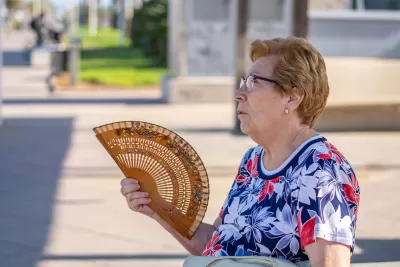Without the resources of larger cities, towns with fewer resources can still work to coordinate efforts across agencies and plan for heat events early in the year.

How can small towns that lack the resources of bigger cities prepare their agencies and residents to prepare for and respond to extreme heat events? Ysabelle Kempe explores the issue in Smart Cities Dive.
While some cities such as Phoenix and Houston have hired Chief Heat Officers tasked with leading cross-departmental efforts to address extreme heat events, others don’t have the funding to do so. In an interview with Smart Cities Dive, Ladd Keith, assistant professor of planning and sustainable built environments at the University of Arizona, said “Because heat is a relatively new climate risk compared to other climate risks, it’s not surprising at all to see that a couple silver bullet strategies have emerged because when you first learned about something, your knowledge is really limited.”
For Keith, one key strategy is coordination between various city and county departments, whether or not the city is able to hire a full-time climate or heat officer. For now, “I think where we’ve ended up is a lot of urban forestry efforts and a lot of focus on cooling centers.” Keith also recommends year-round planning for summer operations. “It’s not great to plan for cooling centers when it’s already hot and when it’s already summer because you’re going to have a little bit less effective coordination and missed opportunities with that.”
FULL STORY: Without chief heat officers, how can smaller cities respond to extreme heat?

Alabama: Trump Terminates Settlements for Black Communities Harmed By Raw Sewage
Trump deemed the landmark civil rights agreement “illegal DEI and environmental justice policy.”

Planetizen Federal Action Tracker
A weekly monitor of how Trump’s orders and actions are impacting planners and planning in America.

Why Should We Subsidize Public Transportation?
Many public transit agencies face financial stress due to rising costs, declining fare revenue, and declining subsidies. Transit advocates must provide a strong business case for increasing public transit funding.

Understanding Road Diets
An explainer from Momentum highlights the advantages of reducing vehicle lanes in favor of more bike, transit, and pedestrian infrastructure.

New California Law Regulates Warehouse Pollution
A new law tightens building and emissions regulations for large distribution warehouses to mitigate air pollution and traffic in surrounding communities.

Phoenix Announces Opening Date for Light Rail Extension
The South Central extension will connect South Phoenix to downtown and other major hubs starting on June 7.
Urban Design for Planners 1: Software Tools
This six-course series explores essential urban design concepts using open source software and equips planners with the tools they need to participate fully in the urban design process.
Planning for Universal Design
Learn the tools for implementing Universal Design in planning regulations.
Caltrans
Smith Gee Studio
Institute for Housing and Urban Development Studies (IHS)
City of Grandview
Harvard GSD Executive Education
Toledo-Lucas County Plan Commissions
Salt Lake City
NYU Wagner Graduate School of Public Service





























